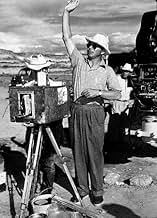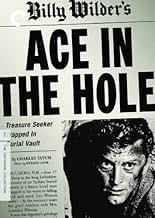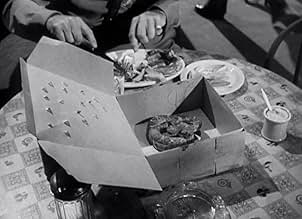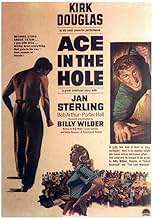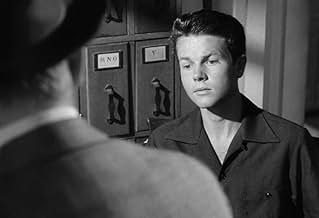अपनी भाषा में प्लॉट जोड़ेंFrustrated former journalist Chuck Tatum now working for an Albuquerque newspaper exploits a story about trading post owner Leo Minosa trapped in a cave to rekindle Chuck's career, but the s... सभी पढ़ेंFrustrated former journalist Chuck Tatum now working for an Albuquerque newspaper exploits a story about trading post owner Leo Minosa trapped in a cave to rekindle Chuck's career, but the story soon escalates into a media circus.Frustrated former journalist Chuck Tatum now working for an Albuquerque newspaper exploits a story about trading post owner Leo Minosa trapped in a cave to rekindle Chuck's career, but the story soon escalates into a media circus.
- 1 ऑस्कर के लिए नामांकित
- 5 जीत और कुल 3 नामांकन
- Herbie Cook
- (as Bob Arthur)
- Barker
- (बिना क्रेडिट के)
फ़ीचर्ड समीक्षाएं
Movies about manipulation of people are usually excellent. I remember Costa-Gravas' "Mad City (1997), Barry Levinson's "Wag the Dog (1997)", Howard Hawks' "His Girl Friday (1940)", and even the recent real case of the chemical weapons. Yesterday I saw "Ace in the Hole" for the first time and I really was impressed how this film is amazingly real and updated. There are elements present in every modern society, such as: the powerful sheriff very corrupt, like most of the worldwide members of the governments; the press, interested in selling news only; the victim used for other interests greater than rescuing him; and the people, completely manipulated and with very short memory. Kirk Douglas is amazing in the role of a nasty reporter. I do not understand why this movie is not in the IMDb Top 250. My vote is ten.
Title (Brazil): "A Montanha dos Sete Abutres" ("The Mountain of the Seven Vultures")
Floyd Collins, a cave explorer working alone (not a real good idea), was trapped in Sand Cave KY, near Mammoth Cave. He was not looking for treasure, but for a new cave suitable for commercializing to produce income in an economically depressed region...and this was before the Depression occurred.
He became trapped on the way out of the cave by a 27 lb. rock which rolled onto his leg in a narrow crawlway. The configuration was such that it could not be moved enough to get his foot past.
When he failed to return home, the family went searching and quickly found him only 150' inside the cave.
A huge rescue effort was mounted and a cub reporter, Skeets Miller, from Louisville KY showed up to cover the story. It became one of the three most widely broadcast events of the time. Besides the extensive newspaper coverage, the relatively new medium of commercial radio riveted listeners with hourly accounts. It quickly became the first media circus ever seen.
Because of the print and radio coverage people began flocking to the site. A carnival atmosphere did indeed spring up around the cave. The state police and National Guard were called out by the governor to control the chaos and the more than 20,000 onlookers. The similarity between the real event and the movie on this account are likely nearly identical.
As in the movie, a decision was made to drill a shaft and, also as in the movie, the rock was fairly unstable and prone to collapse from the pounding of the cable tool drilling rig. The longer the effort went on, the more unstable the cave passage became.
Unlike Kirk Douglas' character in the movie, Skeets Miller served a most honorable role. Due to his small build he became one of very few persons able, and eventually the only one willing, to enter in an attempt to deliver food and water to Collins. He received a Pulitzer Prize for his reporting. Also unlike the movie, there was no manipulation of the event to delay the rescue, but there was considerable disagreement over how to best do it. Area coal miners made the initial attempts and the event concluded with the above-mentioned shaft.
Collins was presumed to have died 3 days before rescuers reached him. Because the conditions were so unstable, the body was left in the cave. The family was able to remove him about 80 days afterward for a proper burial. Later, his glass-topped casket was returned to the now-commercial cave as a tourist attraction. It was removed once again, and finally, in 1989.
In 1982, a definitive account of the event was published in the book 'Trapped!'. A most informative read.
In a take-off of the 'Free Tibet' bumper stickers, vehicles are occasionally seen with a 'Free Floyd Collins' sticker.
With Kirk Douglas playing a Reporter whose been around the block, always looking for a shortcut, comes across an opportunity to exploit a man caught in a mine shaft. I have read where critics had considered the circus atmosphere of the the film unrealistic. It seems Mr. Wilder got the last laugh. If you are interesting in great dialogue and good story telling, I suggest you find this
The idea of such a newspaper reporter manipulating events to stretch out a story at the expense of and disregard for the victim still seems nearly inhuman, but Douglas' performance makes it instantly believable. The story scenario in which locals, then passers-by and finally distant tourists gravitate to and then make a festival or circus out of the event (the film was also released under the title "The Big Carnival") is supported by the real events on which the story was most likely based: the West VA mine disaster in 1925 that trapped miner Floyd Collins and was reported for 17 days, much as in the film, by local newspaperman Skeets Miller, who crawled into the mineshaft for face-to-face interviews with the trapped and doomed Collins.
This movie fits nicely into the Film Noir genre, although it takes place largely under the hot, harsh glare of the Arizona sun, highlighting the sweat and grime visible on the characters' skin and creating a visual metaphor for the sorry state of their souls. I wonder if Henri-Georges Clouzot saw this film before he began filming "The Wages of Fear," because the visually pervasive atmosphere of sweat and filth and opportunism are equally present in both.
क्या आपको पता है
- ट्रिवियाAfter the film was released, it got bad reviews and lost money. The studio, without Billy Wilder's permission, changed the title to "The Big Carnival" to increase the box office take of the film. It didn't work. On top of that, Wilder's next picture, Stalag 17 (1953), was a hit and he expected a share of the picture's profits. Paramount's accountants told him that since this picture lost money, the money it lost would be subtracted from the profits of "Stalag 17".
- गूफ़When Lorraine and Chuck are talking out in front of Minosa's store by the gas pumps, reflections of the crew moving around behind the camera can be seen in the store windows.
- भाव
Charles Tatum: Bad news sells best. Cause good news is no news.
- कनेक्शनFeatured in AFI Life Achievement Award: A Tribute to Billy Wilder (1986)
- साउंडट्रैकThe Hut-Sut Song
(uncredited)
Written by Leo Killion, Ted McMichael and Jack Owens
Sung by Richard Benedict and Kirk Douglas
टॉप पसंद
विवरण
- रिलीज़ की तारीख़
- कंट्री ऑफ़ ओरिजिन
- भाषाएं
- इस रूप में भी जाना जाता है
- Cadenas de roca
- फ़िल्माने की जगहें
- Laguna Pueblo, न्यू मैक्सिको, यूएसए(church exteriors)
- उत्पादन कंपनी
- IMDbPro पर और कंपनी क्रेडिट देखें
बॉक्स ऑफ़िस
- बजट
- $18,00,000(अनुमानित)
- दुनिया भर में सकल
- $23,00,087
- चलने की अवधि1 घंटा 51 मिनट
- रंग
- पक्ष अनुपात
- 1.37 : 1


